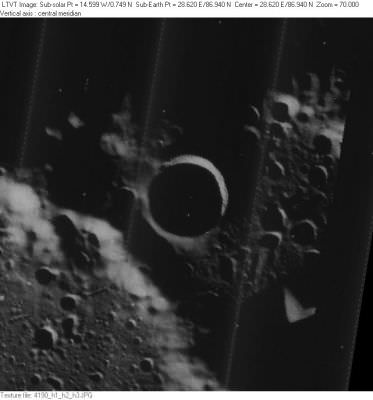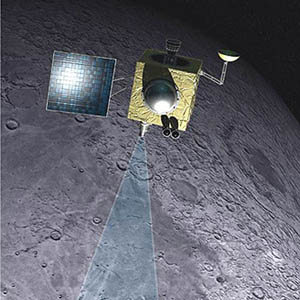NASA’s Lunar Reconnaissance Orbiter and India’s Chandrayaan-1 will team up on August 20 to perform a Bi-Static radar experiment to search for water ice in a crater on the Moon’s north pole. Both spacecraft will be in close proximity approximately 200 km above the lunar surface, and both are equipped with radar instruments. The two instruments will look at the same location from different angles, with Chandrayaan-1’s radar transmitting a signal which will be reflected off the interior of Erlanger crater, and then be picked up by LRO. Scientists will compare the signal that bounces straight back to Chandrayaan with the signal that bounces at a slight angle to LRO to garner unique information, particularly about any water ice that may be present inside the crater.
Both spacecraft are equipped with a NASA Miniature Radio Frequency (RF) instrument that functions as a Synthetic Aperture Radar (SAR), known as Mini-SAR on Chandrayaan 1 and Mini-RF on LRO.
“The advantage of a Bi-Static experiment is that you’re looking at echoes that are being reflected off the Moon at an angle other than zero,” said Paul Spudis,principal investigator for Chandrayaan-1’s Mini-SAR,discussing the mission on The Space Show. “Mono-static radar sends a pulse, and you are looking in the same phase or incident angle. But with Bi-Static, you can look at it from a different angle. The significance of that is ice has a very unique bi-static response.”

Stewart Nozette, Mini-RF principal investigator from the Universities Space Research Association’s Lunar and Planetary Institute, said, “An extraordinary effort was made by the whole NASA team working with ISRO to make this happen”
While this coordination sounds easy, this experiment is extremely challenging because both spacecraft are traveling at about 1.6 km per second and will be looking at an area on the ground about 18 km across. Due to the extreme speeds and the small point of interest, NASA and ISRO need to obtain and share information about the location and pointing of both spacecraft. The Bi-Static experiment requires extensive tracking by ground stations of NASA’s Deep Space Network, the Applied Physics Laboratory, and ISRO.
Even with the considerable planning and coordination between the U.S. and India the two instrument beams may not overlap, or may miss the desired location. Even without hitting the exact location Scientists may still be able to use the Bi-Static information to further knowledge already received from both instruments.
“The international coordination and cooperation between the two agencies for this experiment is an excellent opportunity to demonstrate future cooperation between NASA and ISRO, “says Jason Crusan, program executive for the Mini-RF program, from NASA’s Space Operations Mission Directorate, Washington, D.C.


Congrats to the person who realised that these two probes would be in the right orientation for something like this to be possible.
I would assume that most of the time, the mission controllers are focused only on their own probe, and not really paying much attention to the positioning of other ones.
There is something remarkably beautiful about living in a time when two probes from two separate space agencies can come together in such an ingenious way to conduct an experiment.